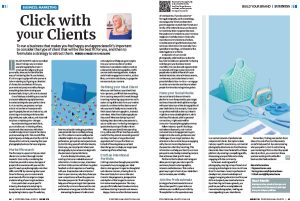
One of the keys to building a successful and sustainable photography business is understanding who your perfect client is. As a creative, you possess a unique artistic vision that will resonate with specific people, brands and industries, and attracting and working with people or companies that align with your style, values, and vision is truly a game-changer. By understanding your ideal client, you can tailor your marketing efforts, create work that resonates with them, and ultimately attract more of the clients you love working with. In this article, we’ll explore ways to help you identify and find those perfect unicorns, ensuring that your photography business thrives and grows.
Market research
The first step in a quest to find your ideal clients is to conduct thorough market research. And the first step of market research is to consider the industries you wish to serve, the types of projects that resonate with you, and the specific needs your photography and other skills can fulfil. By narrowing down your focus, you can concentrate your research efforts and gain a deeper understanding of your target audience.
Once you’re clear on your specific industry, dive deep into analysing their needs, trends, and visual aesthetics. The internet is a treasure trove of information waiting to be discovered. Start by exploring industry-specific websites, forums, and social media groups where your potential clients are likely to hang out. Follow industry leaders, participate in discussions, and observe the challenges and trends prevalent in the market. This online immersion will provide invaluable insights into your ideal clients’ preferences, pain points, and expectations. By familiarising yourself with the industry landscape, you can pinpoint where your photography style and services align with the demands of potential clients.
If you’re already in business, your existing clients are a valuable source of information about your future ideal clients. Conduct client surveys, interviews, or informal discussions to gather feedback on their experiences working with you. Enquire about what attracted them to your services, why they chose you over competitors, and how they perceive the value you provide. Their insights can help you refine your target client persona and identify common characteristics and preferences among your satisfied clients.
Harnessing the power of online tools and analytics will help you gain insights into your current audience’s online behaviour. Use website analytics tools to understand visitor demographics, traffic sources, and browsing patterns. Analyse social media engagement metrics, such as likes, comments, and shares, to gauge the resonance of your content. Monitor keyword search trends related to your field of photography and identify popular topics or emerging areas of interest. These digital insights provide real-time data on your audience’s online presence and behaviour.
Market research is really something you can never go too deep into. You could add aspects such as competitor analysis into the mix in order to get a better understanding of where there might be gaps in the market that you could fill for your ideal clients. But always remember that your goal is to find the clients that align with what you do best, not to try to mould your core creativity to fit the market or what someone else is doing. Your individual flavour of creativity is what makes your work and business stand out, so never dilute your work to try to fit into a market that’s not a good fit for you.
Defining your ideal client
One of my favourite exercises is to craft a target client persona. Taking some time to create a detailed profile of your perfect client really brings them to life and helps simplify everything about your marketing. When you can flesh out your ideal client into a persona, you’ll find that everything from creating new portfolio work to writing marketing copy becomes much easier.
Using all the data from your market research combined with a clear sense of how you would ideally want to work, think about their demographics, interests, and values. What kind of photography work do they need? What are their pain points? By getting clear on who your persona is, you can tailor your marketing messages to speak directly to them. Things to think about: where they spend time online and offline. Are they on social media? Do they attend networking events? Are they members of any professional organisations? Can you find them on LinkedIn? Knowing where your ideal client hangs out can help you target your marketing efforts effectively.
If you’re a commercial photographer, you might wonder how to create a persona that represents a whole brand. You don’t. Generally, you will always be working with specific people within a company. All companies are made of people, and the ones you need to figure out are the people who make decisions about hiring you and whom you’ll most likely form a longer working relationship with.
Craft an intentional portfolio
A well-crafted portfolio is an invaluable tool for photographers seeking to attract their ideal clients. It serves as a visual calling card, showcasing your unique style, creativity, and expertise. By tailoring your portfolio to resonate with your target audience, you can captivate their attention and leave a lasting impression.
Your portfolio serves as a visual narrative that showcases your expertise and style. Curate your portfolio to reflect the specific industries and brands you aspire to work with. Highlight projects that align with their visual identity and demonstrate your ability to bring their creative visions to life. If you go back to issue 207, you can find my article on test shoots and how they should drive your portfolio.
When selecting images for your online portfolio, tailor your selections to reflect the style, mood, and subject matter that resonates with your target audience. Crafting a narrative through your portfolio is a powerful way to engage your ideal clients. Arrange your images in a thoughtful and cohesive manner, allowing them to flow seamlessly from one to the next. Consider the progression, juxtaposition, and rhythm of the images to create an immersive visual experience. The story your portfolio tells should evoke emotions and leave a lasting impression on viewers.
Word of mouth and strategic relationships
Happy clients are often the best source of new business. If you do customer-facing photography such as weddings, encourage your clients to share their positive experiences with their friends and family. Offer referral bonuses or discounts to incentivise them to spread the word. Personal recommendations carry immense weight and can help attract your ideal clients who trust the recommendations of others. Consider partnering with businesses that serve your ideal client. For example, if you specialise in wedding photography, collaborate with a wedding planner or a florist.
In the realm of commercial photography, relationships are also the key. Testimonials are a powerful marketing tool that give your business instant credibility. You can also seek opportunities to network and forge connections with professionals who can be influential in your desired industries. Attend industry events, conferences, and trade shows to meet potential clients face-to-face – or engage in online communities and forums where people from brands and agencies gather. By nurturing these relationships, you position yourself as a trusted collaborator, increasing the likelihood of attracting ideal clients.
Social media, directories and advertising
When it comes to social media, start by identifying the social media platforms most frequented by your target audience. Research which platforms align with your industry and the demographics of your ideal clients. For example, if you cater to a professional B2B audience, LinkedIn might be a more suitable platform, while a platform such as Facebook with its personal connections may work well for consumer-focused photography services. Follow industry-specific hashtags, relevant keywords, and monitor conversations and engagement to gain insights into the needs, preferences, and challenges of your target audience. Pay attention to the content they engage with, the comments they leave, and the questions they ask. This information can help you identify common pain points and develop marketing content that addresses their specific needs.
Platforms like Facebook and Instagram allow you to target your ads to specific audiences based on demographics, interests, and behaviours. This can be a great way to get in front of your ideal client and increase your visibility.
Joining professional associations and directories specific to your niche can enhance your credibility and visibility. These platforms often provide access to a curated network of professionals and potential clients. Examples include industry-specific associations, commercial photography directories, and local business directories. Maximize the benefits of these platforms by creating a compelling profile, showcasing your portfolio, and actively engaging with the community.
Embracing Continuous Growth
In the ever-evolving world of photography, staying on top of trends and emerging technologies is crucial. Invest in professional development, attend workshops, and engage in ongoing education to refine your skills and expand your creative horizons. By embracing continuous growth, you position yourself as an adaptable and innovative photographer, making you more appealing to ideal clients who seek fresh perspectives.
Remember, finding your perfect client takes time and effort, but the rewards are worth it. By understanding who your perfect client is and tailoring your marketing efforts to speak directly to them, you can attract more of the clients you love working with and build a business that feels authentic to you.

A version of this column was originally published in Professional Photo magazine issue 210.
